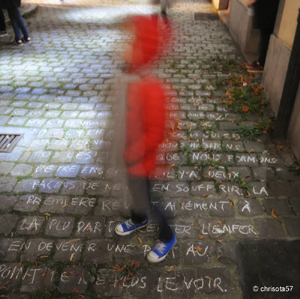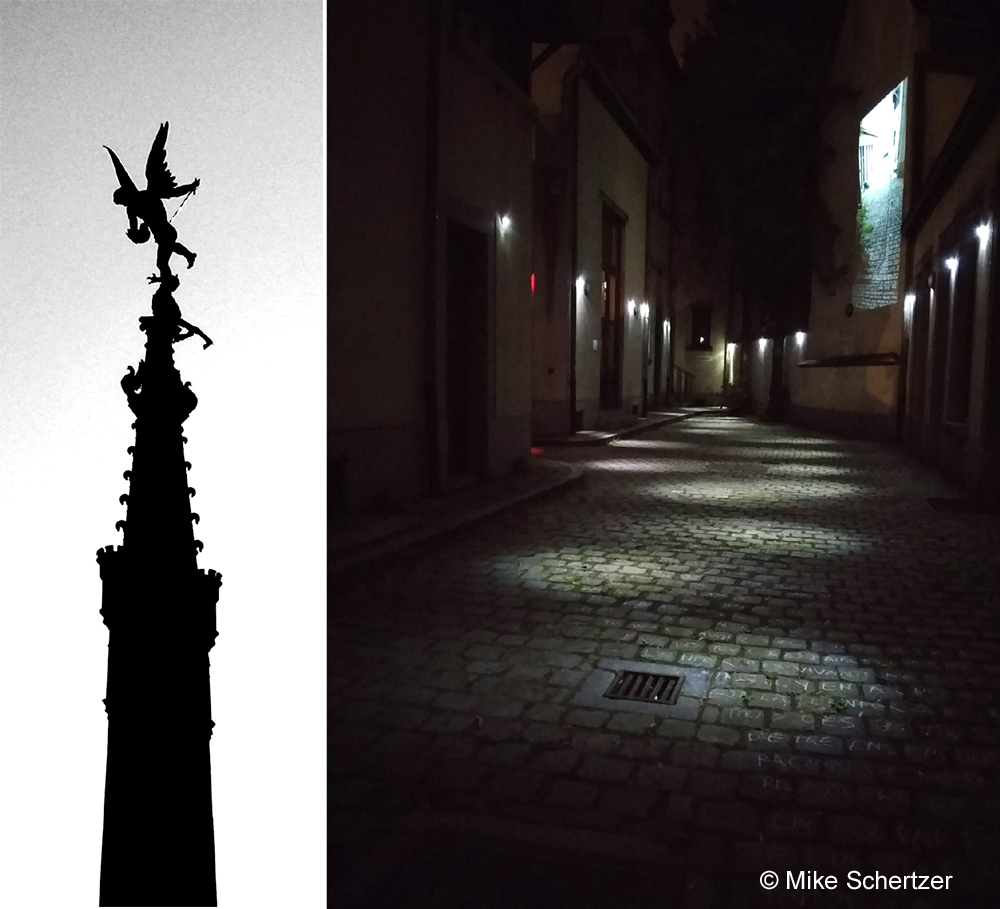Yes, the empire is sick, and, what is worse, it
is trying to become accustomed to its sores. This is the aim of my
explorations: examining the traces of happiness still to be glimpsed,
I gauge its short supply. If you want to know how much darkness there
is around you, you must sharpen your eyes, peering at the faint lights
in the distance.
-
Italo Calvino
|
Entering the Maison des Enfants Saint-André,
look at the cobblestones. There, you will the entire courtyard filled
with words written in white chalk. The text is from the book Invisible
Cities by the Italien writer Italo Calvino. For twelve hours, before
the opening of Nuit Blanche, the artist Mike Schertzer will be copying
the text on the ground. The entire performance will be filmed by Jerome
Noel and projected during the night of the event, in real-time, as
an accompaniment to the installation. In the courtyard the visitor
can read and wander freely. The words speak of things perishable and
of things that last… and this is because they are themselves
ephemeral.
The Maison des Enfants Saint-André is at this
moment a community centre for youths ; among other things, it is mandated
to ‘develop the socialization and autonomy of the child, and
make hom sensible to the socail, cultural, environmental, and scientific
environment of which he is apart’. However, this same building
used to be a morgue. Here, history has made birth and death neighbours.
Here, the commencement of a voyage replete with possibilities finds
itself in the same architectural space where such voyages culminated.
In Invisible Cities Italo Calvino wrote, “At times I feel your
voice is reaching me from far away, while I am prisoner of a gaudy
and unlivable present, where all forms of human society have reached
an extreme of their cycle and there is no , imagining what new forms
they may assume. And I hear, from your voice, the invisible reasons
which make cities live; through which perhaps, once dead, they will
come to life again”.
We create because we are being undone. When we create
we liberate what is possible; when we destroy we become slaves of
the possible. Invisible Cities, its transient traces in white chalk,
speaks playfully and simply of the history of this site, and of its
future… as it does, evidently, of our past, and of our future.
Architecture conditions our humanity. We are where we live and we
are how we live. The places we visit, or avoid, are intimately linked
with who we are and who we will become. We are always a resident,
an inhabitant of something, of some human construction, whether it
be utopian or pragmatic, sublime or abominable, real or imaginary.
- M.S.
|
The inferno of the living is not something that
will be; if there is one, it is what is already here, the inferno
where we live every day, that we form by being together. There are
two ways to escape suffering it. The first is easy for many: accept
the inferno and become such a part of it that you can no longer see
it. The second is risky and demands constant vigilance and apprehension:
seek and learn to recognize who and what, in the midst of the inferno,
are not inferno, then make them endure, give them space.
-
Italo Calvino

thanks to Dominique B, Stéphanie
H, Brufête, Jerome Noel, Toby S, Robin T, Maison St André,
the city of Brussels (and their brewers)...
and the Clinique Saint-Jean !
|




